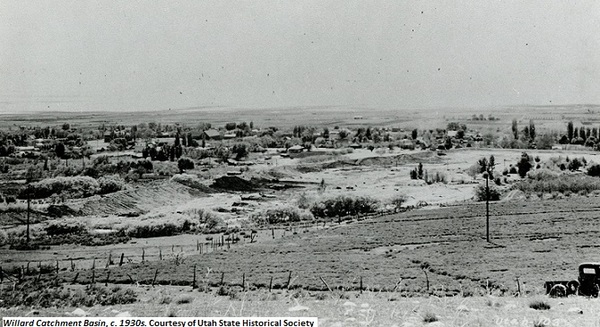Dublin Core
Title
Description
Why would a bunch of young men from New York have spent the summer of 1933 digging ditches in Utah’s Willard Canyon?
It’s the summer of 1933. You’re eighteen years old and recently signed on to the Civilian Conservation Corps, President Roosevelt’s new program for unemployed young men. Now here you are, far from home, in the hot, parched mountains of Utah, digging ditches in a place called Willard Basin. What could possibly have brought you here?
A decade earlier, in August 1923, flash floods devastated the northern Utah town of Willard. The scene repeated itself in the summer of 1930 when another flood of similar proportions ripped through the area. After the second flood, Utah Governor George Dern appointed a committee of geologists, engineers, and range and livestock experts to figure out what made the Willard watershed so susceptible to flooding. They concluded that while some flooding along the Wasatch Front was due to natural causes, most resulted from overgrazing. Ground cover anchored soil and absorbed rainwater, while overgrazing exposed watersheds and made them vulnerable to flooding. Something had to be done to reverse years of poor grazing practices.
The solution came in March 1933, when President Franklin Roosevelt created the Civilian Conservation Corp, or the CCC, as a way to create jobs during the Great Depression. That summer, a crew of young men hailing from New York dug approximately five miles of contour trenches and terraces along Willard Basin at the top of Willard Canyon.
“The trenches…[prevented] surface runoff, [increased] filtration and [promoted] plant growth,” a 1943 Davis County Clipper article explained. “These areas were then planted with grass and shrubs to bind the soil and help restore original watershed conditions.” The federal government continued to fund CCC erosion control work in Willard Basin well into the late 1930s.
Over seventy years later, the terracing built by those workers is still visible in the canyon above Willard and still helps to keep floodwaters at bay.
Creator
Source
Image: Willard Catchment Basin, c. 1930s. Just east of Willard in Box Elder County. Catchment Basin built by U.S. Forest Service to stop damaging flows to town of Willard from Willard Canyon. The Soil Conservation Service is strengthening the walls and making them higher, replacing damaged walls. Courtesy of Utah State Historical Society.
_______________
See Davis County Clipper, “Forest Official Praises Flood Control” September 17, 1943, p 1; Kenneth W. Baldridge, Nine Years of Achievement PhD Dissertation (Brigham Young University, Provo, Utah 1971), 2-3, 58, 214, 215; Davis County Clipper, “Flood Control Work in Hills Brings Visitors, September 25, 1936, p. 1.

